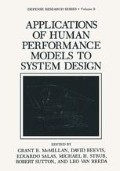Abstract
In order to be able to predict the probability of detection of an acoustic sound in noise, it is necessary to be able to define the masked threshold of that noise along with the level of the sound required to be detected. The phenomenon of obscuring the detection of one sound by another is defined as auditory masking and is one of the more classical problems of the detecting and classifying of signals in noise. Auditory masking is particularly important when threshold listening is involved, that is listening for low level signals in conditions of high noise, and from a military viewpoint it is of great importance when attempting to complete auditory monitoring tasks of sonar signals or electronic warfare returns. Masking, however, is not solely a military problem, but is important wherever a human is required to listen, detect and classify.
Access this chapter
Tax calculation will be finalised at checkout
Purchases are for personal use only
Preview
Unable to display preview. Download preview PDF.
References
Lucas, S.II., 1982, Measurement of Cabin Noise in Lynx Ilelicopters Royal Aircraft Establishment Technical Memorandum FS(F) 498
Lucas, S.II., 1984, Measurement of Cabin Noise in Five Chinook I-Ielicopters. Royal Aircraft Establishment Technical Report TR84101
Moore, B.C.J. and Glasberg, B.R., 1983, Suggested Formulae for Calculating Auditory-filter Bandwidths and Excitation Patterns. J. Acoust. Soc. Am. 74
Patterson, R.D. and Nimmo-Smith, I., 1980, Off-frequency Listening and Auditory-filter Asymmetry. J. Acoust. Soc. Am. 67, 229–245
Patterson, R.D., 1974, Auditory Filter Shape. J. Acoust. Soc. Am. 55, 802–809
Patterson, R.D., 1976, Auditory Filter Shapes Derived with Noise Stimuli. J. Acoust. Soc. Am. 59, 640–654
Patterson, R.D. and Henning, G.B., 1977, Stimulus Variability and Auditory Filter Shape. J. Acoust. Soc. Am. 62, 649–664
Patterson, 1982, Chapter 9 - Voice Communications in “Iluman Factors for Designers of Naval Equipment”. MRC Royal Naval Personnel Research Committee: Operational Efficiency Sub-committee
Rood, G.M., 1978, The Acoustic Attenuation of the Mk 4 Flying Helmet Measured by Semi-objective Methods. Royal Aircraft Establishment Technical Memorandum FS 171
Author information
Authors and Affiliations
Editor information
Editors and Affiliations
Rights and permissions
Copyright information
© 1989 Springer Science+Business Media New York
About this chapter
Cite this chapter
Rood, G.M., Patterson, R.D., Lower, M.C. (1989). Modelling of Auditory Masked Thresholds in Humans. In: McMillan, G.R., Beevis, D., Salas, E., Strub, M.H., Sutton, R., Van Breda, L. (eds) Applications of Human Performance Models to System Design. Springer, Boston, MA. https://doi.org/10.1007/978-1-4757-9244-7_11
Download citation
DOI: https://doi.org/10.1007/978-1-4757-9244-7_11
Publisher Name: Springer, Boston, MA
Print ISBN: 978-1-4757-9246-1
Online ISBN: 978-1-4757-9244-7
eBook Packages: Springer Book Archive

